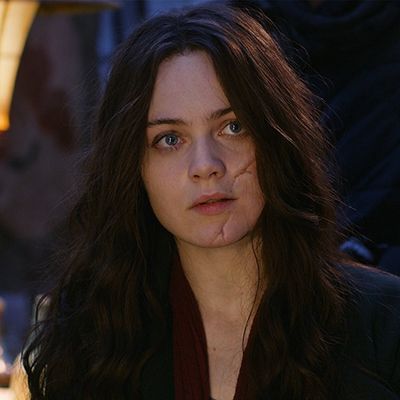
The idea of escapism became a hobbyhorse in the years following the September 11, 2001, attacks, right on time for the first of Peter Jackson’s Lord of the Rings adaptation, The Fellowship of the Ring, to hit theaters. It seemed to refer as much to genre as to run time — Fellowship clocked in at about three hours, Harry Potter and the Chamber of Secrets is 15 minutes shy of that. This fall, I’ve seen more than a few grumbles on Twitter about movies that clear the two-hour mark, and the weight of that ask in the midst of our busy, miserable, Twitter-checking lives, but I remember walking into movies in the early 2000s knowing full well they’d stretch toward the four-hour mark, and feeling not only excited but grateful, and kind of cozy.
We still have long, expensive genre movies, and most of us have become fully disenchanted with Jackson’s brand of stultifying spectacle over the last two decades, so why does something like Mortal Engines feel like such a breath of fresh air? Jackson and fellow Rings producer Fran Walsh’s adaptation of a 2001 YA steampunk novel more than a decade after the release of the ill-advised flop adaptation of The Golden Compass (itself largely blamed for the fall of Rings supposed-powerhouse New Line Cinema) might have seemed craven and misguided even just a few years ago; now it feels preciously, precariously idiosyncratic, a kind of flight of fancy that must be protected at all costs just on principle. But as directed by first-time feature helmer Christian Rivers — who has been working with Jackson since doing storyboard art on 1992’s Braindead — it also happens to be a pretty admirably engineered work of escapism, made all the more astonishing by its ability to stand on its own, independent of a cinematic universe. It’s the increasingly rare multi-million-dollar hero’s-journey spectacle that does feel, improbably, cozy.
To explain the plot of Mortal Engines even in the Cliffiest of CliffsNotes formats would still take up all the rest of my word count, so here are the broad strokes: Earth, some thousand years in the future, has been rendered postapocalyptic by a series of quantum explosions known as the “Sixty Minute War.” The pockets of civilization that were not decimated became “traction cities,” giant mobile cities on tank wheels that roam Europe eating up smaller villages and converting their resources into fuel. Hester Shaw (Hera Hilmar), a hard-knocked orphan with a mysteriously scarred face, is trying to assassinate her mother’s murderer, Thaddeus Valentine (Hugo Weaving), current captain of the traction city of London (which looks like a kind of London-themed Ace of Cakes project complete with St. Paul’s Cathedral sitting on its top tier). She accidentally teams up with a history buff (Robert Sheehan), and they discover that Valentine is building a new quantum doomsday weapon so that London can shoot down a barrier wall currently preventing it from gobbling up all of Asia.
The idea of the traction cities is truly a wacky, see-it-to-believe-it science-fiction conceit, but if it were merely a game of one-upmanship with, say, fellow gearhead fantasia Mad Max: Fury Road, it wouldn’t ring half as true. It’s abundantly clear that author Philip Reeves’s inventions are just baroque exaggerations of lived phenomena: urban sprawl, rural flight, class hierarchies. A bizarre but strangely touching subplot in Mortal Engines involves the terrifying Shrike, a zombie robot on an unstoppable mission to destroy Hester, who eventually becomes a kind of gonzo metaphor for empty-nest parents. Like all good YA fantasy, it’s rooted in earnest adolescent anxieties, and dresses them up with the same level of earnestness. A more mercenary hand would have cut the Shrike plot line, or the majestic moment where Weaving commands his London crew “prepare to ingest!” It’s all the technically unnecessary, illogical stuff in a big-screen spectacle that makes it feel alive, whether it’s a zombie robot dad, or sending our heroes to a floating balloon city because, well, it looks cool.
I suppose that’s the thing that feels fun about Mortal Engines — it’s well-designed, and not in reference or deference to any other franchise or existing look book. It’s well-designed as a means to transport and entertain effectively. It’s for you. Anna Fang’s badass red suit and Matrix sunglasses are for you. The goofy bug-eye goggles on a random fighter pilot are for you. Watching Mortal Engines got me thinking, by contrast, about how infrequently contemporary franchise films feel like they have been crafted first and foremost for the audience. So much of the lumber and clang of a Transformers or any number of Marvel and DC titles feel weighed down by obligation to some other party other than the one that’s paying $15 for a movie ticket. Certainly as an adult, an awareness of financial obligation leaks into everything, and perhaps it’s the dominance of money in the conversation that makes true escapism feel harder to come by. When even a glimmer of originality rears its head in the form of a blockbuster, the marvel is less “How did they do that?” or “How did they come up with that?” and more “Who did they get to pay for for that?”

